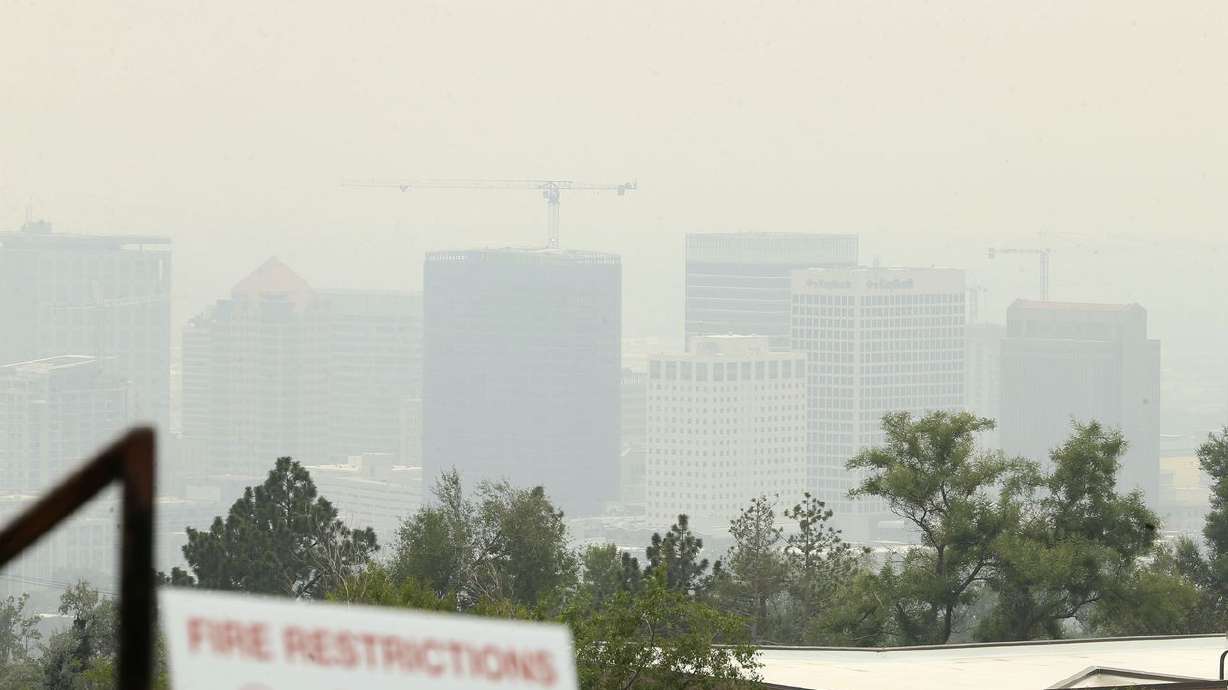Estimated read time: 5-6 minutes
This archived news story is available only for your personal, non-commercial use. Information in the story may be outdated or superseded by additional information. Reading or replaying the story in its archived form does not constitute a republication of the story.
SALT LAKE CITY — A new study released amid a summer that has seen wildfire smoke blanketing Utah and the West adds to research that shows exposure to wildfire smoke during pregnancy increases the risk that a baby will be born early.
The Stanford University study published Aug. 14 estimated nearly 7,000 preterm births in California were attributable to wildfire smoke exposure from 2007 to 2012. Preterm births occur before 37 weeks of pregnancy, when incomplete development increases risk of neurodevelopmental, gastrointestinal and respiratory complications, or death.
The Stanford study's findings build on an already established link between pollution and adverse birth outcomes, including preterm birth, low birth weight and even death. However, the study is the first to isolate wildfire smoke effect on early births and the first to "tease out the importance of exposure timing," a Stanford news release stated.
The study's results suggest "each additional day of exposure to any wildfire smoke during pregnancy was associated," researchers wrote, with a nearly .5% increase in risk of preterm birth of less than 37 weeks. This translated to a 3.4% percent increase in risk, relative to an unexposed mother, with a sample median smoke exposure of seven days, according to the study.
Wildfire smoke contains high levels of the smallest and deadliest type of particle pollution, called PM2.5, or fine particulate matter. "These specks of toxic soot are so fine they can embed deep in the lungs and pass into the bloodstream, just like the oxygen molecules we need to survive," according to the news release.
The new study comes as huge wildfires continue to rage through bone-dry landscapes in the West amid a record-breaking "megadrought" — only a year after a historic wildfire season burned up more than 4 million acres in California, leading to some of the worst air pollution days on record in the state.
This year could be worse, said Stanford environmental economist Marshall Burke, a co-author of the new study, according to the Stanford news release.
This summer, smoke from large fires in California have seeped toward the state's eastern neighbors, enveloping states including Utah, Idaho, Wyoming and Nevada.
Earlier this month, WorldIQ Air rated Salt Lake City air quality the worst in the world compared to other major cities across the globe, thanks to several days of heavy Western wildfire smoke blanketing Utah.
The Utah Department of Environmental Quality's Division of Air Quality forecast has classified air quality levels in counties along the Wasatch Front as "unhealthy" for all groups for several days this summer when wildfire smoke was settling particularly thick across the Salt Lake Valley.
"One possible explanation for the link between wildfire smoke exposure and preterm birth," the authors say, "is that the pollution may trigger an inflammatory response, which then sets delivery in motion. The increase in risk is relatively small in the context of all the factors that contribute to the birth of a healthy, full-term baby."
"However, against a backdrop where we know so little about why some women deliver too soon, prematurely, and why others do not, finding clues like the one here helps us start piecing the bigger puzzle together," said co-author Gary Shaw, a professor of pediatrics and co-primary investigator of Stanford's March of Dimes Prematurity Research Center.
The study showed wildfire smoke may have contributed to more than 6% of preterm births in California in the worst smoke year of the study period, 2008. That year, a severe lightning storm — combined with strong winds, high temperatures, and a dry landscape — led to a destructive fire season. That year has already been dwarfed by 2020's record-setting infernos and this year's California blazes.
"In the future, we expect to see more frequent and intense exposure to wildfire smoke throughout the West due to a confluence of factors, including climate change, a century of fire suppression and construction of more homes along the fire-prone fringes of forests, scrublands and grasslands," said the study's lead author Sam Heft-Neal, a research scholar at Stanford's Center on Food Security and the Environment.
"As a result, the health burden from smoke exposure — including preterm births — is likely to increase."
The study also found there's "no safe level of exposure" to particulate matter.
Using satellite data of smoke plumes from the National Oceanic and Atmospheric Administration, researchers identified smoke days for over 2,600 zip codes. They paired the data with estimates of ground-level PM2.5 pollution, and pulled additional data from California birth records.
"After accounting for other factors known to influence preterm birth risk, such as temperature, baseline pollution exposure and the mother's age, income, race or ethnic background, they looked at how patterns of preterm birth within each zip code changed when the number and intensity of smoke days rose above normal for that location," Stanford's news release stated.
"They found every additional day of smoke exposure during pregnancy raised the risk of preterm birth, regardless of race, ethnicity or income."
A full week of exposure translated to a 3.4% greater risk relative to a mother exposed to no wildfire smoke, according to the study. Exposure to "intense" smoke during the second trimester (between 14 and 26 weeks of pregnancy) had the strongest impact.
"Our work, together with a number of other recent papers, clearly shows that there's no safe level of exposure to particulate matter. Any exposure above zero can worsen health impacts," Burke said. "While as a society it will be extremely difficult to fully eliminate all pollutants from the air, our research suggests that further reductions in key pollutants below current 'acceptable' levels could be massively beneficial for public health."










